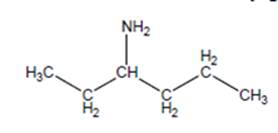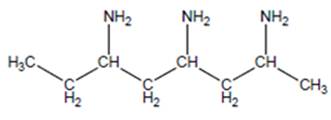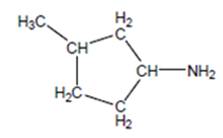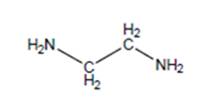
Concept explainers
(a)
Interpretation:
The name of the following structure is to be determined by using the word amino.

Concept Introduction:
The chemical name of the compound can be defined as the name of each elements which are present in chemical composition of the compound.
(b)
Interpretation:
The name of the following structure is to be determined by using the word amino.

Concept Introduction:
The chemical name of the compound can be defined as the name of each elements which are present in chemical composition of the compound.
(c)
Interpretation:
The name of the following structure is to be determined by using the word amino.

Concept Introduction:
The chemical name of the compound can be defined as the name of each elements which are present in chemical composition of the compound.
(d)
Interpretation:
The name of the following structure is to be determined by using the word amino.

Concept Introduction:
The chemical name of the compound can be defined as the name of each elements which are present in chemical composition of the compound.
Want to see the full answer?
Check out a sample textbook solution
Chapter NW2 Solutions
Custom eBook for Organic Chemistry
- Synthesize N-Methylcyclohexylamine from cyclohexanol using the necessary organic or inorganic reagents. Draw the structures of the compounds.arrow_forwardSynthesize N-Methylcyclohexylamine from cyclohexanol using the necessary organic or inorganic reagents. Draw the structures of the compounds.arrow_forwardIf possible, please provide the formula of the compound 3,3-dimethylbut-2-enal.arrow_forward
- Synthesize 1,4-dibromobenzene from acetanilide (N-phenylacetamide) using the necessary organic or inorganic reagents. Draw the structures of the compounds.arrow_forwardIndicate the products obtained by mixing (3-oxo-3-phenylpropyl)triphenylphosphonium bromide with sodium hydride.arrow_forwardWe mix N-ethyl-2-hexanamine with excess methyl iodide and followed by heating with aqueous Ag2O. Indicate the major products obtained.arrow_forward
- Indicate the products obtained by mixing acetophenone with iodine and NaOH.arrow_forwardIndicate the products obtained by mixing 2-Propanone and ethyllithium and performing a subsequent acid hydrolysis.arrow_forwardIndicate the products obtained if (E)-2-butenal and 3-oxo-butanenitrile are mixed with sodium ethoxide in ethanol.arrow_forward
- Question 3 (4 points), Draw a full arrow-pushing mechanism for the following reaction Please draw all structures clearly. Note that this intramolecular cyclization is analogous to the mechanism for halohydrin formation. COH Br + HBr Brarrow_forwardIndicate the products obtained if 2,2-dimethylpropanal and acetaldehyde are mixed with sodium ethoxide in ethanol.arrow_forwardIndicate the products obtained if 2,2-dimethylpropanal and acetaldehyde are reacted with sodium ethoxide in ethanol.arrow_forward
 Organic Chemistry: A Guided InquiryChemistryISBN:9780618974122Author:Andrei StraumanisPublisher:Cengage Learning
Organic Chemistry: A Guided InquiryChemistryISBN:9780618974122Author:Andrei StraumanisPublisher:Cengage Learning
